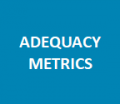Welcome to Resource Adequacy Assessment Resource Center
The purpose of this site is to bring together information to help those trying to assess resource adequacy. It draws on a wide range of work that EPRI and the industry has conducted in response to the challenges arising as power systems evolve. We welcome your feedback and suggestions to make this website increasingly useful to support you and your decisions.
Resource Center Layout
This resource center focuses on basic RA concepts, methods, and metrics, as well as more application-focused topics such as study tool choices and methods to assess the impact of certain technology classes. Each of the links below brings you to a dedicated section for each of these issues, faced practitioners when conducting adequacy studies.
What is Resource Adequacy?
Resource adequacy (RA) is an assessment of whether the current, or projected, resource mix is sufficient to meet capacity and energy needs for a particular grid. The resource mix includes all resources able to provide energy, capacity, or flexibility to the system, including traditional centralized thermal, large-scale wind and solar power, and distributed resources, including demand response and energy efficiency programs. RA assessments are used to identify potential shortfalls in the availability of resources across different time frames, from long-term planning (5 to 20+ years), to seasonal and day-ahead assessments. As the RA look-ahead time approaches real-time operations, options to address identified shortfalls become fewer and more expensive.
Reliability is considered to have two main components: adequacy and security (also commonly referred to as deliverability). The latter ensures that the grid is able to maintain power flow and quickly recover stability after disturbances.
Read more
- CIGRE, “The future of reliability - Definition of reliability in light of new developments in various devices and services which offer customers and system operators new levels of flexibility,” Technical Brochure No 715, 2018
- North American Electric Reliability Corporation (NERC), “Definition: Adequate Level of Reliability for the Bulk Electric System,” March 2013 (Link)
- Electric Power Research Institute, “Capacity and Energy in an Integrated Grid”, EPRI, Palo Alto, CA: 2015, 3002006692 (Link)
What does it mean to have adequate resources?
RA criteria are probabilistic, meaning that any given system that meets such criteria is expected to have sufficient supply and demand-side resources to meet periods during which scarcities are more likely to arise, i.e. peak system demand, with a certain level of confidence. Resulting from the probabilistic nature of adequacy criteria, a system that is planned for adequacy may still experience temporary, and rare, periods of scarcity, some of which may lead to involuntary load shedding. Load shedding refers to the interruption of customer load to balance supply and demand, all while ensuring that sufficient operating margins remain available to respond to unforeseen disturbances and contingencies.
Adequacy criteria intrinsically recognize that some periods of scarcity may occur, albeit at a very low probability. Typically, scarcity events occur during times when a confluence of system conditions arise with a low likelihood of occurrence in combination. These combinations of conditions are generally considered so rare, that planning for them is not economically justifiable. In fact, certain power systems derive their adequacy criteria economically, searching for the limit of cost-justifiable actions to ensure reliability. Whether searching for an optimal level of adequacy, or projecting resource needs to meet an adequacy target, it is critical that a realistic range of conditions is considered in RA assessments, with some being beyond past experience. It should be noted that loss of load resulting from external factors such as storm damage, wildfires, or other natural disasters that interrupt delivery of power are not currently considered in resource adequacy assessments.
Who is responsible for resource adequacy?
Setting adequacy requirements, assessing adequacy, procuring capacity, and contracting, are all distinct tasks, even though they are intertwined, and all relate to ensuring sufficient capacity. Adequacy standards and requirements normally originate in laws, regulations, or license agreements. State public utility commissions and other regulators may hold RA proceedings and approve requirements, standards, and the actions necessary to secure adequacy. RA assessments are conducted by a variety of entities. In regions with centralized wholesale markets, they may be conducted by independent system operators (ISOs), transmission system operators (TSOs), regional security coordinators (in Europe), or regulators, irrespective of who may be responsible for ensuring adequacy. In other regions, utilities are directly responsible for assessing and ensuring adequate supply, using methods and criteria subject to approval by regulatory and other authorities. In the structured-market areas, there are three primary classifications of methods by which capacity is secured: 1) centralized capacity markets (e.g. PJM), 2) decentralized or regional capacity procurement (e.g. California) and 3) no explicit capacity markets (“Energy Only” markets such as in Texas).
How is resource adequacy changing?
Read More
- North American Electric Reliability Corporation (NERC), Generating Availability Data System (GADS), (link)
- European Network of Transmission System Operators for Electricity (ENTSO-E), Mid-term Adequacy Forecast (link)
- National Grid Electricity System Operator, Electricity Market Reform (link)
- Electric Power Research Institute, Considering Generator Cycling in Resource Adequacy. EPRI: 2018, 3002013488 (link)
- Electric Power Research Institute, Developing a Framework for Integrated Energy Network Planning (IEN-P). EPRI: 2018, 3002010821 (link)
Until recently, RA in most systems referred to having sufficient planned capacity (traditionally, dispatchable generation) to meet the expected peak demand over a study period, which may range from months to years or decades. Several factors are impacting the ability of planners to assess resource adequacy.
Changing Generation Mix. There is a growing diversity of technologies for power generation, from traditional thermal generation, i.e. coal, nuclear, and natural gas-fired generation, to weather-dependent renewable generation such as hydropower, wind, and solar. The latter vary widely in their ability to produce electricity to meet demand. Additionally, demand-side resources, such as controllable, or deferrable demand, as well as energy storage resources, can also contribute to RA, although their contributions may be more complex to evaluate compared to other resources.
Changing Demand Characteristics. There are a number of factors that can impact demand characteristics. Improving energy efficiency, for example, affects future projections of energy demand. The growth in certain types of generation, i.e. solar power, also affects load shapes, creating new types of stressful periods, large net-load ramps can particularly stress systems if generators cannot respond quickly, even if there is sufficient capacity installed. Electrification of various parts of the economy also changes load shapes and magnitudes by impacting electricity consumption, but also by providing demand-side flexibility. Furthermore, climate change impacts on demand should also be considered, particularly in studies with greater look-ahead horizons. Energy-Limited Resources. The evolution of RA assessment is also shifting from traditional capacity-only considerations, towards including both available capacity and energy supply. Although hydro-dominated systems have historically seen this dual need for capacity and energy, it is becoming increasingly present in traditional thermal-dominated systems as certain modern resources, like batteries and demand response, are energy-constrained depending on their previous usage. To produce a more accurate picture, RA models are becoming more sophisticated by including all the above elements, as well as transmission capacity, fuel availability, and other factors. The very nature of what constitutes an adequate system is increasingly an open question in the era of flexible demand. These changes are discussed in the later section on challenges.
Is the risk of capacity shortages only during the peak demand period?
Read more
While the annual peak demand is most likely the period of highest risk, capacity shortfalls may also occur at other high daily peaks and in the period surrounding the peak hours. Some systems experience peaks in both the winter and the summer, reflecting heating and cooling load. Increasingly, the greatest likelihood of a capacity shortage occurs at the peak net-load interval. Net load represents the “net” demand not served by wind and solar generation, and which must be met by traditional resources. Risk can also arise during spring and fall when maintenance outages typically occur. In order to better understand system firm load shedding risk, modelling and assessing RA is often conducted using hourly data covering many possible demand scenarios, rather than just focusing on the daily peak. The importance of considering scenarios other than peak demand is highlighted in events such as the 2020 summer rolling outages in California, where shortages occurred at a time that did not coincide with the typical peak demand period of either day or year.
What happens when a real-time capacity shortage is declared?
As system operators forecast a capacity shortage risk, they may take several actions to address it, including:
- Days ahead, market notices about the expected grid conditions are issued to market participants;
- When possible, plants undergoing non-essential planned outages are recalled into service, and new outages are deferred;
- Support from neighboring regions may be requested;
- Public conservation notices may be issued depending on the magnitude of the forecasted shortfall;
- Resources contracted for “capacity adequacy” are notified, and those that take a comparatively long time to come online are instructed start-up such that they’re online when required; and
- Distribution network operators may be notified of the need to implement conservation voltage reduction.
As conditions evolve these actions are updated. At the day-ahead and intra-day stages, forecasts are regularly updated to reflect changing demand and renewable production positions. If available generation, storage, import, and demand-response capacity is insufficient to meet operating reserve plus forecasted demand, scarcity pricing may be invoked. In scarcity periods, energy-market prices often increase reflecting the tightened supply/ demand balance and reach market ceiling levels (e.g. 9,000 $/MWh, 1,000 €/MWh).
As a real-time scarcity event worsens, the available mitigating actions may reduce to only load shedding. Expected production, demand schedules, and grid topology are analyzed for congestion and energy deliverability issues. Should an operational threshold be reached (typically a shortfall of operating reserves), coordinated, rolling, involuntary interruption of loads is conducted, for the duration of the scarcity event, known as load shedding. The operational goal is to maintain grid cohesion by holding sufficient operating reserves.







